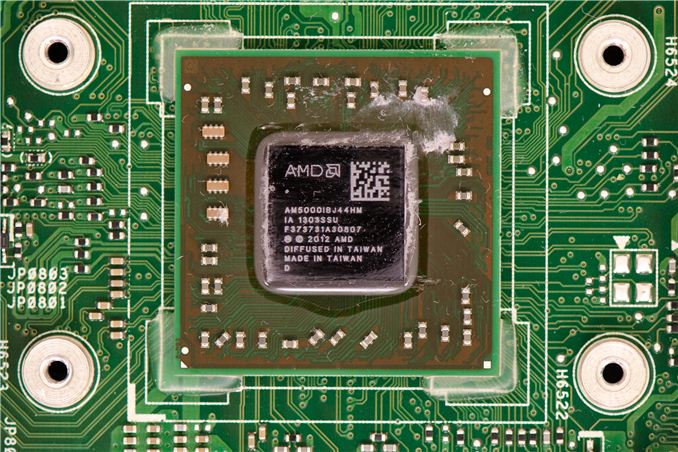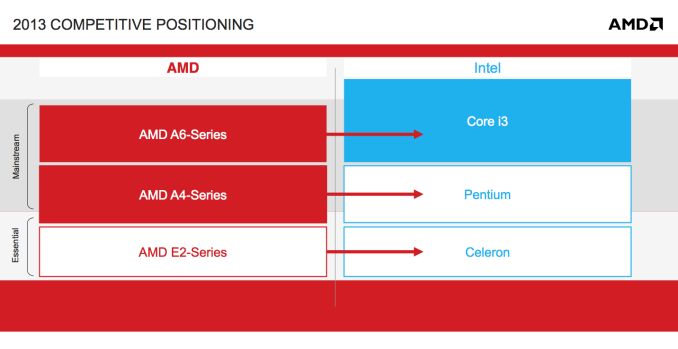The Kabini Deal: Can AMD Improve the Quality of Mainstream PCs with Its Latest APU?
by Anand Lal Shimpi on May 24, 2013 1:45 PM EST
There are two non-negotiables in building a PC these days: the cost of Intel silicon and the cost of the Windows license. You can play with everything else but Intel and Microsoft are going to get their share. Those two relatively fixed costs in the PC bill of materials can do one of two things: encourage OEMs to skimp on component cost elsewhere, or drive the entire ecosystem to supply higher quality components at lower prices. If you’ve been following the PC industry for the past decade, I think we’ve seen more of the former and less of the latter.
Apple occupying the high-end of the notebook PC space has forced many OEMs to reconsider their approach, but that’s a more recent change. What AMD seems to offer is an easier path. AMD will take less of the BoM, allowing OEMs to invest those savings elsewhere - a move Intel will never make. Given how much pressure the PC OEMs have been under for the past few years, AMD’s bargain is more appealing now than it has ever been.
With Llano and Trinity, AMD’s story was about giving up CPU performance for GPU performance. With Kabini, the deal is more palatable. You only give up CPU performance compared to higher priced parts (you gain performance compared to Atom), and you get much lower power silicon that can run in thinner/lighter notebooks. Typically at the price points Kabini is targeting (sub-$400 notebooks), you don’t get pretty form factors with amazing battery life. AMD hopes to change that.
While AMD hasn’t disclosed OEM pricing on Kabini (similarly, Intel doesn’t list OEM pricing on its mobile Pentium SKUs), it’s safe to assume that AMD will sell Kabini for less than Intel will sell its competing SKUs. If Kabini’s die size is indeed around 107mm^2, that puts it in the same range as a dual-core Ivy Bridge. AMD can likely undercut Intel a bit and live off of lower margins, but there’s one more component to think about: Ivy Bridge needs its PCH (Platform Controller Hub), Kabini does not. As a more fully integrated SoC, Kabini’s IO duties are handled by an on-die Fusion Controller Hub. Intel typically charges low double digits for its entry level chipsets, which is money AMD either rolls into the cost of Kabini or uses as a way of delivering a lower total cost to OEMs.
Traditionally, OEMs would take these cost savings and pass them along to the end user. I get the impression that AMD’s hope with Kabini is for OEMs to instead take the cost savings and redeploy them elsewhere in the system. Perhaps putting it towards a small amount of NAND on-board for a better user experience, or maybe towards a better LCD.
As we found in yesterday’s article, Kabini does a great job against Atom and Brazos. However, even with double digit increases in performance, Kabini is still a little core and no match for the bigger Ivy Bridge parts. Much to our disappointment, we pretty much never get sent low end hardware for review - so to make yesterday’s NDA we had to stick with 17W Ivy Bridge and extrapolate performance from there. In the past day I grabbed an ASUS X501A system, a 15-inch entry-level machine priced in the low $300s. More importantly, it features a 35W Ivy Bridge based Pentium CPU: the dual-core 2020M.
The Pentium 2020M’s base clock speed is still relatively high at 2.4GHz, but there’s no turbo. In the low level CPU performance analysis yesterday I used a Surface Pro with a 17W 1.7GHz Core i5, but max turbo on that part can hit 2.6GHz. I actually don’t expect there to be huge CPU performance differences between the results from yesterday and what I have here but I wanted to be sure.
The bigger difference is actually on the GPU side. While a mobile Core i5 comes with Intel’s HD 4000 graphics, the Pentium 2020M gets a vanilla Intel HD GPU. At 22nm, Intel’s HD graphics is a 6 EU part with lower performance than the previous generation Intel HD 3000.
With that said, let’s see how Kabini (AMD’s A4-5000 in particular) compares to an Ivy Bridge based Pentium 2020M in CPU performance, GPU performance and finally in power.











108 Comments
View All Comments
ppeterka - Friday, May 24, 2013 - link
My wife has an E-350 with an SSD. Ever since she got the SSD, she never forgets to mention how much she likes her laptop. Not a power user though, but very representative of an "average end-user".And I, being an Anandtech reader for 15+ years, and working professionally in IT, qualifying as a mid-power user, would like to have this in a small form factor chassis: 10.1" display with 1366x768 resolution, and as small footprint as possible. Oh, yes, and with 8+ GB RAM, and an at least second tier SSD. Throw in extended battery option, and I'll even try to sing to get that... (Ok, that last bit would actually be bad for everyone...)
DanNeely - Friday, May 24, 2013 - link
Same here. Even for casual goofing around use I regularly find myself doing enough typing that a physical keyboard is a must have. If any of these systems ship with a decent battery the atom based envy x2 I bought both because my old netbooks battery life has gotten anemic and to fiddle with win8 on a touchscreen system will end up with a shorter lifetime than I thought it would.OTOH 7W haswell might be able to get the same runtimes at better CPU and GPU performance levels at the cost of a higher purchase price.
flyingpants1 - Monday, May 27, 2013 - link
Take the Asus X202E for $399 from Amazon mentioned in the article (11.6" 1366x768, Core i3, 4GB) and add in a 128GB SSD for $60-100, you have MOST of what you want for $459-499. Netbook form factor, ultrabook performance, while keeping the price of a lower-end Celeron/AMD setup.Nothing wrong with an extended battery option, they'd simply need to provide a battery slice attachment for the bottom of the laptop.
At least you are willing to make some sacrifices. For me if I replace my current laptop, I just can't deal with anything smaller than 15" because it need to be just as functional as my desktop.. At that point might as well go for the 3630QM with nvidia dGPU because they start at around $700ish. Add full 1080p, and 128GB SSD. Need 6-8GB of RAM with option to expand, and I don't want battery life to be anemic, so why not use a 90Whr battery like in the rMBP? It ends up costing me $1200+.. I think I'll just keep the laptop I have.
HalloweenJack - Friday, May 24, 2013 - link
thanks for the adition;AMD seem to be going very very well in the market its aiming for = 5w >25w (above ARM and below i3) and here it rules - and as shown , matches intels 30w parts @ 1/2 the power.
name99 - Friday, May 24, 2013 - link
"matches intels 30w parts @ 1/2 the power."Let's be very careful here. What is matched is Intel's crappy low-end low-price 30W part. This thing is no match for a high performance (and high price) ULV i5.
Point is, AMD is competing on price, pure and simple. Don't try to pretend they're somehow specifically competing in the 5W..25W market with a technical edge. They're competing in the "low performance for a low price" market. No shame in that; but let's not pretend otherwise.
juhatus - Saturday, May 25, 2013 - link
The price is same so they _are_ competing with pentiums and low I3's.RoyYoung - Friday, May 24, 2013 - link
This would have been interesting back in the pre-tablet age. A cheap SOC that offers just enough performance for media consumption and light gaming, with good power efficiency to allow for 5+ hour battery life on hardware that is still reasonably cheap and light.The problem for this in the 2013 market place is the rise of tablets, along with the epic collapse in PC sales has leave no room for this class of x86 SOC. For media consumption and light gaming, an ARM tablet can be have with IPS screen, SSD storage, and a large library of games that are newer and optimized for the low power platforms. All these for comparable price, lower weight and better battery life. Why settle for crappy game play on 3~4 year old PC titles when you can get a much better experience from tablet games? For general computing, I see $299 pentium and celeron machines going on sale regularly, not just reserved for black Friday specials. Up at the $4xx price point it is not hard to find ivory b i-3s or sandy b i-5s. Go up to $5xx and there are even ULV i-3s and i-5s to choose from.
The Kabini is clearly designed to beat up the old intel atom and it does indeed look good in that comparison. The problem is the old atom power netbooks has already disappear from the market, and for good reason. Intel has now positioned atom SOCs for tablets and cell phones. Entry level laptop segment is now populated with pentiums, celerons, and even older generation i-3s and i-5s.
I am not an AMD fanboi but I really want to see them turn things around to keep Intel in check. May be Temash will fare better going up against atom in the tablet space, but Kabini is sadly not the hit that AMD desperately needs.
JarredWalton - Friday, May 24, 2013 - link
Note that tablets at lower price points do NOT have SSD storage; they have flash storage, but almost always low performance eMMC. Even 5400RPM HDDs can outperform eMMC. Put Kabini/Temash in a tablet and run Android, though, and I suspect it will look very good against most ARM offerings. Or maybe in a Chromebook. But like Anand said: please give it a good screen and don't just skimp everywhere and go after the minimum cost market! The race to the bottom is already over, and the winner is...no one.tipoo - Friday, May 24, 2013 - link
Some of the faster tablets and probably soon smartphones (Nexus 10 for example) are getting up to 90MB/s sequential on the NAND, even if hard drives have higher peak transfer rates wouldn't other characteristics (seek time on a hard drive) make up for that? And the hard drives would rarely hit peak anyways.JarredWalton - Friday, May 24, 2013 - link
In the future, we'll see more tablets start to trend towards faster NAND. My point is that the currently shipping stuff is mostly crap -- especially in the $300-$400 tablets. I wonder if Tegra 4 and SHIELD are going to be better? Tegra 3 so far has had horribly slow NAND every time I've seen it. (Yay for installs taking several minutes.)